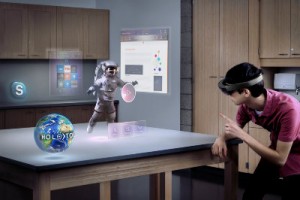Virtual reality (VR) technologies have been in our crosshairs here on IPWatchdog since they were able to grab a lion’s share of the attention at this year’s Consumer Electronics Show in Las Vegas. We got a look at the latest head-mounted displays to hit the consumer market as well as some intriguing ways that VR is entering sectors like video games or automotive tech.
Microsoft Corporation (NASDAQ:MSFT) of Redmond, WA, is looking to add to the list of virtual reality innovations coming out in 2016 with its holoportation 3D capture technology. Implemented through Microsoft’s HoloLens or another mixed reality display, holoportation is designed to give individuals in different rooms the sense that they exist and can communicate within the same space.
Fans of the Star Wars movie franchise might remember Princess Leia’s desperate plea for help to Obi-Wan Kenobi via hologram in Episode IV. Microsoft’s holoportation system goes a step beyond that by offering real-time interaction between remote participants, although a headset is needed to fully participate. The three-dimensional content feed is created by putting a person in a space with a multi-camera array which records video of a participant from multiple angles. Those different angles are spliced together to create a holographic version of a person moving through space and viewable through a headset.
Microsoft’s holoportation system also allows for more reflectivity in human communications by recording 3D sessions for later viewing. Users can don the HoloLens or another compatible headset to view themselves and other subjects during a holoportation session. The system also lets users reduce the size of the 3D content playback so that a life-size scene can be replayed on a surface the size of a chess board.
Microsoft’s position in VR headsets is likely to see some competition from a Los Angeles-based startup known as Daqri. In late March, Daqri landed British holographic tech firm Two Trees Photonics, a company which had focused on building dynamic holography displays for automotive windshields. Daqri will likely incorporate the Two Trees technology into its Smart Helmet product, an augmented reality platform implemented on a headset and designed for the enterprise community.
Holographic technologies are being prized by major companies for their eye-catching qualities, which is important in such a media-rich world as ours. In April’s issue of Fast Company, German high-performance vehicle manufacturer Porsche unveiled what it calls the world’s first interactive hologram print ad. The acetate or glass prism coming with issues of the business innovation magazine is placed on top of a tablet which turns a video on Porche’s official website into a hologram appearing above the device. Another luxury auto manufacturer, British-based Bentley Motors, is looking to expand augmented reality offerings in its vehicles by recently teasing a holographic butler in media releases.

![[IPWatchdog Logo]](https://ipwatchdog.com/wp-content/themes/IPWatchdog%20-%202023/assets/images/temp/logo-small@2x.png)


![[Advertisement]](https://ipwatchdog.com/wp-content/uploads/2024/04/Artificial-Intelligence-2024-REPLAY-sidebar-700x500-corrected.jpg)
![[Advertisement]](https://ipwatchdog.com/wp-content/uploads/2024/04/Patent-Litigation-Masters-2024-sidebar-700x500-1.jpg)

![[Advertisement]](https://ipwatchdog.com/wp-content/uploads/2021/12/WEBINAR-336-x-280-px.png)
![[Advertisement]](https://ipwatchdog.com/wp-content/uploads/2021/12/2021-Patent-Practice-on-Demand-recorded-Feb-2021-336-x-280.jpg)
![[Advertisement]](https://ipwatchdog.com/wp-content/uploads/2021/12/Ad-4-The-Invent-Patent-System™.png)






Join the Discussion
No comments yet.